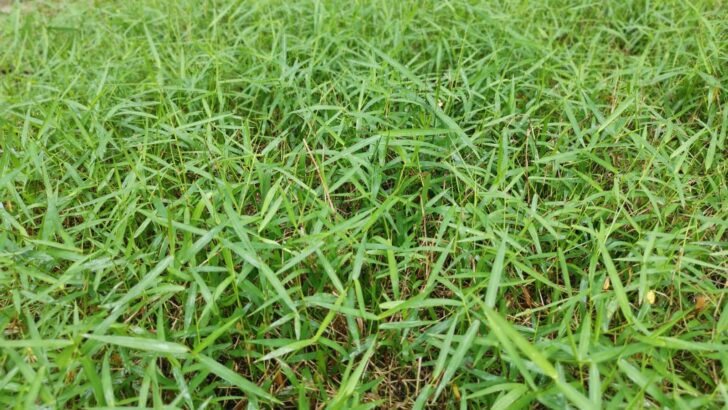Depending on who you ask, Bermuda grass (Cynodon dactylon) is either an excellent turfgrass or a terrible weed. It spreads aggressively and tolerates drought, heat, and foot traffic, making it perfect for filling in a lawn and staying lush and green throughout summer.
But if Bermuda grass ends up where you don’t want it, it can be nearly impossible to get rid of. So if you don’t have (or want) Bermuda grass in your yard, don’t plant it! For those of you who do have Bermuda grass and just want it gone, I’ve rounded up some of the best methods for how to get rid of Bermuda grass once and for all that I’ve used in my own yard.
What is Bermuda Grass?
Before we look at how to control bermudagrass, let’s take a moment to understand the plant, as some basic background knowledge can help us know how to best get rid of the weed. Bermuda grass is a warm-season turfgrass species. In addition to its tolerance of heat and drought, it also spreads rapidly via aboveground stolons and belowground rhizomes. This means it can quickly resprout from small fragments, so if any piece of the plant is left behind (or dropped elsewhere!) during removal, that little piece can grow and spread. Yikes.
Its strong, aggressive root system allows bermuda grass to quickly reestablish itself after vegetation loss, such as mowing or grazing. This depletes the energy stores in the roots, but new vegetation can restore that energy stockpile through photosynthesis, assuming all of the plant’s needs are met (e.g., sunlight, water, and nutrients).
How to Get Rid of Bermuda Grass
The good news is that there are several effective methods for getting rid of Bermuda grass, and most of them require no chemical treatment. While any one of these options will help control Bermuda grass, using two or more methods will be the most effective in truly eradicating the weed.
1. Dig
For small amounts of Bermuda grass cropping up here and there in the garden or lawn, the best option might be to simply pull or dig out the weed. This is easiest to do when the soil is moist and loose, so if it hasn’t rained recently, you might want to water the area an hour or so before weeding.
Try to remove as much of the plant as possible, including all of the roots, so it doesn’t resprout. You may have to remove Bermuda grass from the same spot a couple of times before it finally stops growing there.
2. Smother
Smothering works well for larger swatches of Bermuda grass. Also called occultation, this method involves laying an opaque material over the patch of weeds for one to two months. Six-millimeter black plastic sheeting is the go-to material for occultation, but large pieces of cardboard (e.g., from flattened appliance boxes) work well, too; just make sure to overlap the edges to prevent any light from getting through.
You’ll also want to mow or string-trim the Bermuda grass as short as possible first. The plastic or cardboard traps heat and moisture, causing weed seedlings to sprout, but they die without sunlight.
Once the Bermuda grass has been sufficiently smothered, you can remove the plastic or cardboard and plant grass or clover seed, sow a wildflower mix, or create a new garden bed. If you plan to turn the space into a garden bed, you can leave the cardboard in place — it will eventually break down — and plant through it. Keep an eye on the area and pull or dig any Bermuda grass that survived the occultation and resprouted.
3. Solarize
Solarization is a similar process to occultation, but it involves the use of clear plastic. Because it uses sunlight to create extreme temperatures that kill not only weeds but also bacteria, nematodes, and insect pests, this process works best in the hot summer months.
Mow the Bermuda grass short, then pull the plastic taught and weigh down the edges with boards or bury the edges with soil to help seal in the heat. Leave the plastic in place for one to two months. As with occultation, once the Bermuda grass has died, pull up the plastic and plant what you desire in that space.
4. Spray
A study by Oklahoma State University found Torched Weed Killer, advertised as an all-natural (but not organic) product, to be one of the top three most effective herbicides for suppressing Bermuda grass. If you choose to use weed killer as part of your Bermuda grass removal plan, carefully follow the instructions on the label to apply it, and take care not to spray any on nontarget plants.
As with the other control methods listed here, you will need to watch for resprouting and reapply the weed killer as needed. Alternatively, combine an herbicide application with one of the other control options to reduce your chemical use and increase the effectiveness of both methods.
5. Prevent
Once you have successfully removed Bermuda grass from your yard or garden, you will want to keep it from coming back! Keep an eye on the areas where it has grown before to make sure it doesn’t resprout, and pull up any new Bermuda grass as soon as you see it.
A healthy lawn is less likely to contain weeds, so make sure to mow regularly to a height of 3.5 inches. You can also consider replacing your grass lawn with an attractive low-mow alternative like clover — less mowing, fewer weeds, and more pollinators! Or you can ditch grass altogether and plant flowers, native drought-resistant plants, and things you can eat.
To prevent Bermuda grass from invading your garden, place edging around the beds. The type of material is not important, but the edging should extend six inches deep to keep rhizomes from growing underneath, while the aboveground portion will stop creeping stolons. A thick layer of mulch will discourage Bermuda grass seed germination.
With its creeping rhizomes and stolons, Bermuda grass spreads aggressively and is nearly impossible to completely eradicate. But with the proper knowledge and tools, you can take steps to suppress this obnoxious weed and maybe even get rid of it entirely!



How To Grow Grass Between Pavers The Easy Way
Thursday 10th of August 2023
[…] But if you get Bermuda grass when you don’t want it, here’s how to get rid of it. […]
Virginia Native Plants List: 14 Pretty Blooming Garden Flowers
Thursday 10th of August 2023
[…] Chinaberry, English ivy (learn how to remove English ivy for good), tall fescue, Russian olive, and Bermuda grass. Take some time to learn about the invasive species common in your area and how to avoid […]